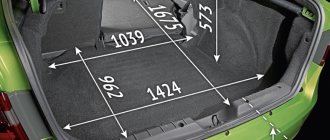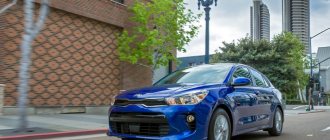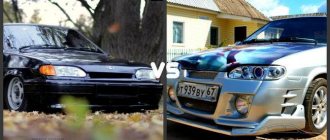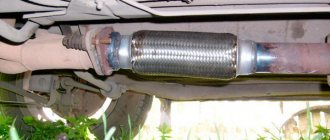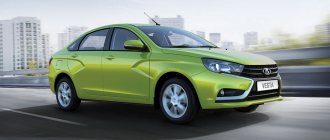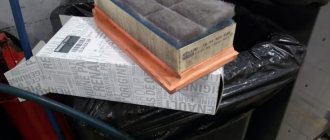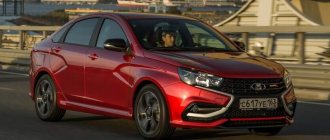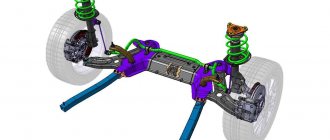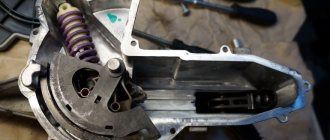Comparison of cars
Machine Specifications
Differences inside the cabin
Recently, more and more often, owners began to ask what is better than Lada Vesta or Hyundai Solaris. The latter unconditionally dominated the sales market, but received a serious competitor from Russian designers. How do you know what to choose? Let's try to consider all the advantages of the car. Neither one nor the other engineers and designers will have to blush for the quality of the product - this is an indisputable fact.
Body and representativeness of models
Korean concerns have recently begun to show steady growth in the field of car prestige and stand on a par with German and Japanese cars. AvtoVAZ creations also strive for these heights, wanting to demonstrate similar representativeness of their latest development. If you compare the Lada Vesta and the Hyundai Solaris based on the first impression and the status that they show, you cannot say for sure which is better.
In terms of dimensions, the following indicators can be distinguished, given in the passport documents of both models:
- the height of the Lada Vesta is 1497, the Hyundai is 3 cm lower;
- the Russian new product is slightly longer 4410 vs 4375;
- Hyundai loses in terms of body width: 1.7 m versus 1765 mm;
- trunk volume is almost equal – 470 and 480 kg;
- ground clearance of the Hyundai Solaris - 16 cm, for the Lada Vesta - 17.8 cm;
Which is better to choose?
The question of choosing a car in this case will be very difficult. Both sedans belong to the budget class, but at the same time they have very good equipment and quality for their level. After the update, a Korean car is unlikely to show significant changes in its durability. But the Russian has already managed to prove its reliability, contrary to the judgments of some skeptics. At the same time, Lada allows you to save a lot of money by buying a modern, high-quality and incredibly stylish car for very little money. It is also suitable for those who want to spend less money on maintenance. The opponent will appeal to those who appreciate the famous quality of a popular brand and at the same time are willing to overpay a little for it.
Both brands offer an excellent selection of trim levels to suit every taste. The cars are aimed more at a youth audience, although their buyers may include people of different ages. Among them there may be both men and women.
The cars are ideal as a family car or a car for every day. Thanks to their small dimensions, not too high gasoline consumption, as well as the presence of versions with automatic transmission or robot, they are convenient to use in the city.
But sedans can also be bought by those who often drive long distances on the highway. They are also suitable for lovers of car travel. But connoisseurs of fast driving most often give preference to Vesta, although the Korean, which does not have a “charged” version, drives quite well.
Solaris will appeal to those who want to emphasize aggressiveness and follow modern automotive fashion trends, while Vesta will suit those car enthusiasts who are not afraid to stand out from the crowd and be original.
Cars can be successfully purchased for work, including in taxis.
For those who often drive on bad roads or minor off-road conditions, many experts advise buying a Russian sedan. But, as practice shows, its rival is also very well suited for summer residents and lovers of outdoor recreation. True, its trunk may be a little small for this.
According to experts, those who do not want additional costs and all sorts of problems with operation should not purchase a domestic sedan with a robot. But it’s also not worth buying Solaris for those people who often have to overcome even mild off-road conditions. This car has too low ground clearance for that.
Both sedans are good in their own way. Each of them has many undeniable advantages, but they are also not without their disadvantages. And let everyone decide for themselves which car to choose, based on their preferences, wishes and capabilities. The Russian car will definitely find many new buyers in the new year. But the restyled Asian is definitely worth a closer look.
Appearance
Comparison of cars If you choose a car by appearance: both of them are good in their own way. The Korean copy is designed in the style of the constantly evolving current line. The image extremely refreshes the product, making it harmonious wherever it is placed.
- the body profile is slightly inclined;
- the radiator grille is distinguished by two chrome strips;
- the rear of the car looks quite attractive.
Even the bravest patriot could not predict that the new product would look like this and could be compared with foreign models. Among the features and lines of the Lada Vesta, the following elements can be distinguished:
- in the front part, chrome eyeliners and a sharp-shaped bumper are noticeable, which gives some sportiness;
- “X-style” stampings spread throughout the entire area of the car body;
- the stern part is different in height.
Interior
Inside, both competitors are good, and each of them flaunts a unique design. The quality of materials is approximately the same, but the assembly is still better than Solaris. The interior design of the Hyundai, with its teardrop-shaped center console and blue lighting, is very unique and attractive. Vesta responds with more traditional solutions, as well as a spectacular dashboard with deep wells.
Both interiors are attractive in their own way.
While driving, it becomes obvious that Vesta has better sound insulation - the engine is not heard so clearly. But the main thing is that there is noticeably less noise from the wheel arches, especially when driving on gravel and puddles. In addition, if Vesta is reproached for the short driver’s seat cushion, then in Solaris this is also added to by an excessively high seating position, which is typical for Korean cars. But the “Korean”’s control of the air conditioner is clearer and simpler.
Vesta's noise insulation is noticeably better. Layout of protection mats.
There's plenty of space in the back. Vesta is more spacious in the back row, but its transmission tunnel is higher, which makes seating for a third passenger not so comfortable. In Solaris, the door handles in the rear doors are poorly located - reaching for them is very inconvenient.
Comparison of technical characteristics of internal combustion engines
The Russian plant proposes as many as three engines for different configurations of the Lada Vesta. The sedan is equipped with a 106 horsepower/1.6 liter engine. The engine is reliable, works without defects or complaints. It accelerates to hundreds in 12 seconds. on a manual transmission, and on a “robot” the figure is 12.8 seconds. Consumes 10 liters of fuel in the city, accelerates to 178 km/h.
The Hyundai Solaris has a 107-horsepower unit with a volume of 1.4 liters. The torque is slightly lower: 135 Nm versus 148 Nm on the Vesta engine. Thanks to its lighter weight, the foreigner accelerates half a second faster. The presence of a manual transmission significantly increases the maximum speed of the Hyundai Solaris. Its engine consumes relatively little gasoline when driving in the city - 7.6 liters. All parameters are officially confirmed on video (test drive).
On a note!
With the advent of Vesta’s 1.8/122 hp engine, we can say that the Russian car can now compete in this area with the Korean 1.6/122 hp engine, which is distinguished by its nimble characteristics. AvtoVAZ cooperates with Renault and Nissan, which are developing a very practical and reliable engine.
Exterior
It's no secret that the first thing that the vast majority of potential customers pay attention to is the external design of the car. As for the exterior, we can say with confidence that both candidates offer excellent shape, but still, most drivers and professionals are inclined to think that Vesta looks more attractive.
It immediately becomes clear that domestic specialists approached the matter with all diligence, and as a result, the overall impression of the design is more than good. “Solaris” has a lot of oriental style, while “Vesta” is still more related to European style traditions.
The use of the new X-Design concept in the appearance of Vesta did not escape motorists either. The table below contains the dimensions of both machines:
| Characteristic | "Vesta" | versus | "Solaris" |
| Length | 4410 mm | 4370 mm | |
| Width | 1764 mm | 1700 mm | |
| Height | 1497 mm | 1470 mm | |
| Clearance | 170 mm | 160 mm | |
| Base length | 2635 mm | 2570 mm |
As you can see from these data, Vesta is close in size to class C, in addition, the car looks larger, more solid and more representative than Solaris.
Comparison of transmissions and chassis
Both cars have both an automatic transmission and a robotic one. The Hyundai Solaris has not only a five-speed transmission, but also a six-speed one. The latter is designed for a more powerful foreign engine.
Technical characteristics of cars Lada Vesta is endowed with only one type of robotic gearbox, and the “Korean” can boast of two: one with four ranges, the other with six. The “robot” of the Russian car cannot compete with the latest variation of the Korean transmission, but is much better than the one that uses 4 shift stages.
The chassis of both cars is considered standard in category B. MacPherson struts are located on the front axle of the suspension of both Solaris and Vesta. Both cars handle great despite the large difference in ground clearance. The Korean auto industry uses hydraulic power steering, and Russian designers have equipped their product with electric power steering, but the behavior of the cars on the highway and on the road is almost the same.
Important!
The chassis of the Lada Vesta is more energy-intensive compared to the Hyundai Solaris, so it copes better with off-road conditions and uneven road surfaces. The maximum speed of both models, when the car behaves obediently, is determined to be 120 km/h.
What troubles await Solaris buyers?
From a reliability point of view, Solaris is more trustworthy. Over nine years of operation, drivers have identified many “sores” and found ways to treat them. This:
- increased engine oil consumption;
- weak fastening of the cooling radiator impeller;
- gearbox input shaft bearing grinding noises;
- “kicks” of the automatic transmission;
- Steering rack leaks.
There are currently 6,392 first-generation Solaris available on the secondary market. Before buying, pay attention not only to the technical condition of the car, but also to the history, so as not to run into a problematic copy. For example, this car is sold at a “tasty” price of 315 thousand rubles:
A check through avtocod.ru showed that the car has registration restrictions, unpaid fines and estimates for repair work:
The car, as the list of operations calculated by insurance shows, was involved in an accident. The rear of the car was badly damaged; restoration took almost 260 thousand rubles.
It is better to refuse this option.
Also read: Which is better: Vesta or Polo
Differences inside the cabin
Differences inside the cabin A comparison of Lada Vesta and Hyundai Solaris shows that competitors stand out clearly and especially with their own interior. Buyers may like the following about a Korean car:
- The center console features a seven-inch touchscreen in blue.
- The rearview camera has intriguing navigation and markings.
- The entire interior is upholstered in high-quality hard plastic.
- It is possible to adjust the position of the front seats; each seat has a headrest.
- It is now possible to heat the rear sofa.
- The 480-liter trunk lid now opens automatically if the owner just stands nearby with the keys.
The competitor of the Korean product puts forward its advantages, focusing on traditions:
- The dashboard fits perfectly into the dynamic appearance of the cabin.
- The opinion of professionals is this: Vesta’s sound insulation is somewhat better (especially when driving on gravel terrain).
- Vesta has quite a lot of space in the rear.
- The interior surface is trimmed with fabric and, to a lesser extent, leather.
- There is a rational distribution of devices, and the sensors are read by the owner easily and quickly.
- The headrests can be adjusted in height.
Other options
As an alternative to these cars, you can also consider the Volkswagen Polo, which is very popular in our country. It costs a little less than Solaris, but somewhat more expensive than Vesta. The German has excellent driving performance and stable reliability. Its maintenance and service will not require significant financial costs. As in the case of the Korean, the car cannot boast of excellent cross-country ability. And many experts and car enthusiasts consider its minimal configuration to be poor.
In what configurations are they present on the market?
The price of Lada Vesta is slightly lower than that of its competitor. You can buy a Russian new product at a price of 515 thousand rubles, and in order to buy an excellent Solaris, which is a real bestseller, you need to have about 550,000 rubles in your pocket. Buyers will have to pay significantly extra to have a “robot.” By choosing Lada Vesta or Hyundai Solaris, the owner will not be disappointed if he is planning to buy a car for traveling around the city and on the highway. The warranty for a foreign car is five years, for Vesta – three years.
The basic equipment of a Russian car is somewhat more varied, which makes its purchase more tempting. However, while the Hyundai Solaris has a more powerful engine and a six-speed automatic transmission, it is the most popular class B product. Reviews in 2017 increasingly equate these two models, as the Lada Vesta is progressing very quickly in trim levels (coupe, station wagon).
Conclusion ZR
To purchase a Solaris with decent equipment you will need at least 800,000 rubles. There is simply no Vesta with such a price tag yet. At least until the “pseudo-off-road” Cross station wagon appears. It is not surprising that now the new Solaris is gradually losing ground to Vesta.
Cheap Solaris or expensive Vesta - advice from ZR
results
It is very difficult to determine exactly who won in this review - both products performed more than worthy. Vesta’s convenience, dimensions, and design are definitely better, but Solaris has an advantage in speed characteristics. The fight really turned out to be intense, but Vesta competed on an equal footing – the product can rightfully be called outstanding without any discounts. Just 2 years ago, it never occurred to anyone that a car could appear in our country that would be able to challenge the famous models of the foreign automotive industry.
checkpoint
- The Korean manufacturer offers 4 different boxes, and AvtoVAZ offers 3 pieces. Moreover, in Solaris, two of the four gearboxes can be automatic (4- and 6-speed automatic). Vesta, alas, does not have an automatic transmission in any variant.
- Lada Vesta is equipped only with a manual transmission (5 steps). Of these, one gearbox is domestically developed, and the second is manufactured by Nissan. There is also a third option, which is mechanics on a robot. The robotic part itself was designed in Russia. I must say that during the driving process this solution showed itself quite well, especially compared to a number of budget analogues of foreign production.
It is due to the presence of an automatic transmission that Solaris takes over in this section. But we can assume that lovers of dynamic driving will prefer Vesta.
Chassis
The new generation Hyundai Solaris 2021 has a standard suspension consisting of independent front MacPherson struts and a semi-independent rear beam. But in the modernized version, the mounting points for the chassis and shock absorbers are slightly shifted, which made it possible to widen the track of the front and rear wheels and had a positive effect on the driving performance of the car.
Lada Vesta has a similar type of suspension. Both cars are distinguished by convenient handling, stability on the road and comfort. The Russian car is a little more sensitive to road irregularities and leans noticeably during long turns at speed. Its advantage is excellent maneuverability, which is achieved thanks to high ground clearance. The ability to travel comfortably on any, even the most difficult, roads is a very important characteristic for the Russian consumer.
